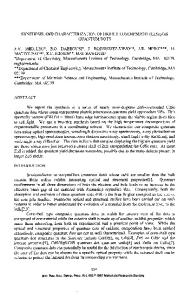Synthesis of water-soluble PbSe quantum dots
- PDF / 389,981 Bytes
- 5 Pages / 585 x 783 pts Page_size
- 80 Downloads / 334 Views
Synthesis of water-soluble PbSe quantum dots Lioz Etgara) Nanoscience and Nanotechnology, Technion, Israel Institute of Technology, Haifa 32000, Israel
Efrat Lifshitz Chemistry, Technion, Israel Institute of Technology, Haifa 32000, Israel
Rina Tannenbaum Chemical Engineering, Technion, Israel Institute of Technology, Haifa 32000, Israel; and School of Materials Science and Engineering, Georgia Institute of Technology, Atlanta, Georgia 30332 (Received 25 October 2007; accepted 22 January 2008)
Water-soluble PbSe semiconductor quantum dots (QDs) with near-infrared absorption of 1100–2520 nm (corresponding to a diameter of 3–13 nm) were synthesized using 2-aminoethanthiol (AET). The oleic acid-stabilizing ligands used in the traditional synthesis of PbSe were exchanged with the 2-AET ligands, which promoted the solubilization of the QDs in an aqueous medium. This occurred due to the attraction of the surrounding water molecules to the exposed amino group, thus allowing the particles to reside in the water environment. The water-soluble PbSe QDs have very narrow size distribution ( ≈ 4.5–5.5%). Transmission electron microscopy, spectrophotometric measurements, and Fourier transform infrared spectroscopy indicate that the morphology, size, size distribution, and chemical composition of the PbSe QDs remained unchanged during the transfer to an aqueous medium. In conclusion, the ability to synthesize water-soluble PbSe QDs with stable properties and uniform size distribution will allow them to have substantial advantages for biological applications such as biosensors and drug delivery.
I. INTRODUCTION
The synthesis and use of nanoparticles constitute a major research area that has attracted both academic and industrial interest.1,2 Due to quantum confinement effects, semiconductor nanocrystals [i.e., quantum dots (QDs)] exhibit special physical and chemical properties that are greatly different from those of their corresponding bulk materials.3–6 Over the past two decades, great efforts have been put into the synthesis of highly fluorescent II-VI semiconductor nanocrystals.7–12 One of the multitude of synthesis methods, the TOP (trioctylphosphine)/trioctylphosphine oxide (TOPO) synthetic approach, has become one of the most successful and mature methods for preparing highly fluorescent II-VI QDs to date.7,8,10 However, the direct product of the TOP/TOPO synthetic approach is insoluble in water, which to some ex-
a)
Address all correspondence to this author. e-mail: [email protected] This paper was selected as the Outstanding Symposium Paper for the 2006 MRS Fall Meeting Symposium M Proceedings, Vol. 959E. DOI: 10.1557/JMR.2008.0136 J. Mater. Res., Vol. 23, No. 4, Apr 2008
http://journals.cambridge.org
Downloaded: 19 Mar 2015
tent limits the application of TOP-stabilized QDs as biolabeling materials.13,14 Many applications require these particles to be water dispersible and to remain suspended in water with no loss of physical or chemical properties over extended periods of time.2 Unfortunately, waterbas
Data Loading...











